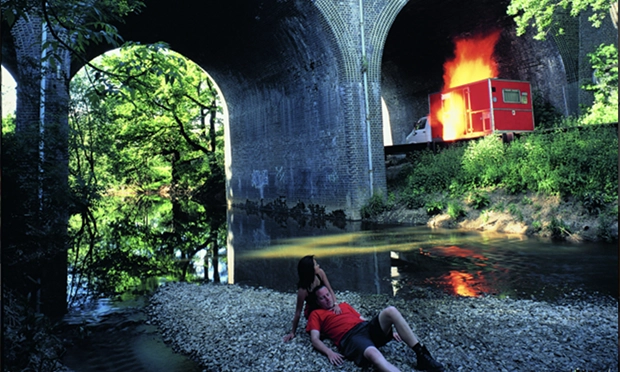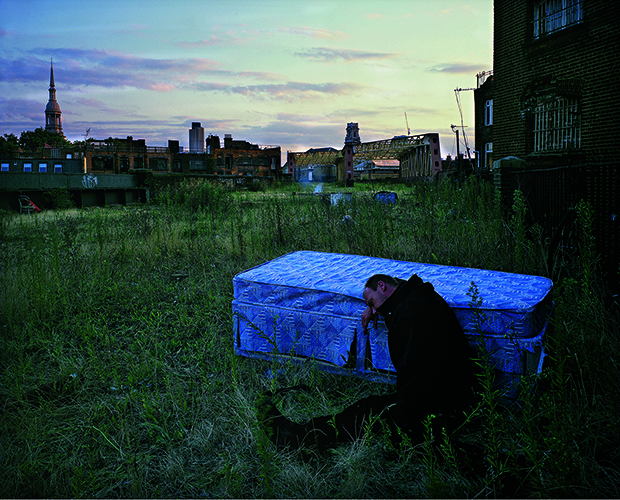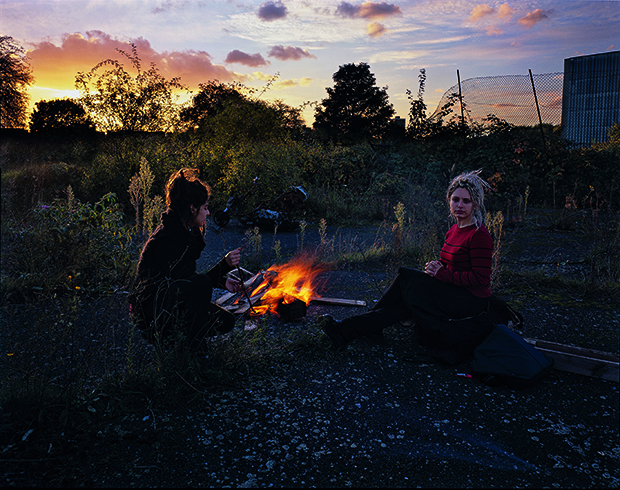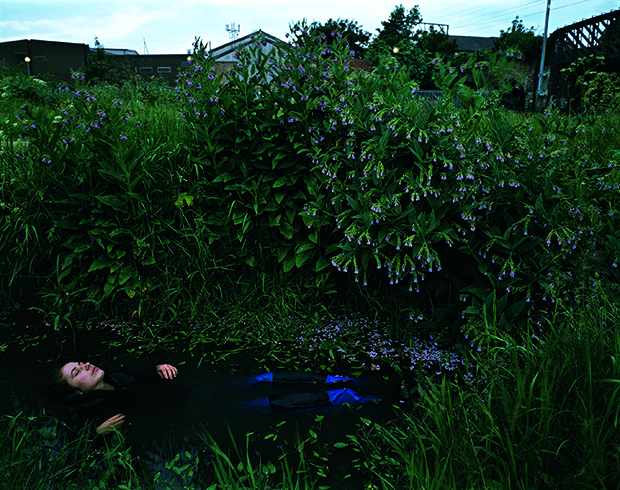‘We need more social housing’: Photographer Tom Hunter on Hackney’s evolution and the threat of ‘monoculture’

The Outlaw, from Life and Death in Hackney. Photograph: Tom Hunter
Artist Tom Hunter is known for his lyrical images of East London on the cusp of gentrification, just as the terrain of squatters, raves and DIY culture was being eyed up by developers.
The photos that make up Life and Death in Hackney 1991–2001 were first shown at the turn of the century.
Now the Grey Gallery in London Fields has put on a display of seven large-format works from the series, and I went along to ask Hunter what he thought of recent changes in the borough.
SB: “A lot of the places in these photos have now been built over with flats. Some people would say, ‘we have a housing crisis, we need all of that’. But we’ve also lost something. What do you think?”
TH: “It’s a double-edged sword. Lots of them were taken around the Olympic site. That was the end of the industry, the ended the factory era. Lots of [the buildings] are old warehouses, so it is great that they’ve been made into new flats.
“The trouble is, they’ve been made into flats for only a certain type of people, people with a huge amount of income. It’s really polarised the whole community.
“I’ve got children, and there’s no way they can afford to buy in these places now.
“So, it’s great that things have changed in lots of ways, but it’s also very sad that we haven’t put enough social housing into Hackney.

After The Party, 2000. Photograph: Tom Hunter
“I hate Paris because of the way it’s been hollowed out. All the working-class people, all the people who actually work, have all moved to the peripheries.
“The central part has been hollowed out and become like a museum, and I really don’t like that.
“If we’re not careful, that could happen in Hackney, and it is happening in Hackney.
“We have got a lot of standing estates in Hackney, but even those are being hollowed out now and we’re not building enough social housing.
“I’m up for development. London always changes and we need change as part of the city, but we need to have social housing.
“Without that, we could end up like Paris or New York, which would be really sad, where normal people with normal jobs have to come in from Tottenham, or from Croydon, or from Luton.”
SB: “One of the first Tom Hunter works I ever saw was a film you made about Woodberry Down Estate, A Palace for Us. A lot has changed on the Woodberry Down Estate since you made that film. They have built a lot of social housing there, but also other types of housing, and it’s now a lot denser. What do you think of the development that’s happened there since you made that film?”
TH: “When I made that film, it was at the height of the financial crash. They had a showcase, and I went in there and they had a model of all the tower blocks, and they were selling them off-plan.
“Being a bit clever, I said to them: ‘you’re not going to sell these. Have you sold any of these?’. And they said: ‘we’ve sold 90 per cent of them’. I said, ‘how have you sold them?’ They said: ‘we’re selling to people from China, Singapore, America; they’re all buying for the Olympics’.
“They’re renting them out and they’re AirBnBing them, and really missing the local community.
“That was really sad. It was a community under a lot of social pressures. It was really problematic there. But at the same time, there was a really strong working-class community, who brought up families, who raised their children there. And it’s changed.

The Vale of Rest. Photograph: Tom Hunter
“I don’t mind new people moving into Hackney. That’s always been part of the East End to bring in new people. But when it’s only focused on people who just want to buy to make money, and they don’t become part of the community, that’s very problematic.
“It’s a beautiful development, it’s lovely, the way it’s opened up to the lakes and the reservoirs. But again, we need more social housing there. We need to celebrate and to work with the community that’s there and to build upon that. I think we missed an opportunity there.
“I think what we really need to do is what’s happening in Berlin and Vienna, [which] are a really good examples of where they are taking control of the housing stock: they’re renting out, they’ve got controlled rents, they’re stopping Airbnbs and they’re looking after the local community. And as a city, we need to do that.
“Sadiq Khan and the Labour Party need to take control. And then we could make this place great, because we’ve got lots of amazing people moving here. But lots of people I know, artists, they can’t afford studios here anymore. Their children can’t afford to live here anymore.
“And if you haven’t bought 20 years ago in Hackney, the only people who can buy here now are people from overseas or bankers, and that makes it very monoculture.
“We have this amazing tradition in London of social housing, which makes this city so vibrant, so mixed and so diverse. And we need to celebrate that and to focus on that.”
SB: “What parts of Hackney intrigue you now?”
TH: “Luckily we still have lots of amazing communities. We’ve got the Chinese Community Centre on my old street, Ellingfort Road. And we’ve got an amazing array of people who have come here: the Vietnamese, the Chinese, the Turkish community, the Hasidic Jews, the African community, the West Indian community. That’s always exciting.
“I keep on meeting people; my daughter is 16 and her friends are from all over the world. I’m always excited when she brings friends around and they’re from here and there and doing amazing different things.
“There are so many stories and so many people eeking out a living and making it work in Hackney. I still love Hackney for that.
“It’s not a monoculture just yet, but we have to safeguard that, we have to work to keep that diversity and that inclusiveness.”

The Way Home, 2000. Photograph: Tom Hunter
SB: “And finally, what are you working on?”
TH: “I’m doing quite a few different projects. I’m working on a project with the V&A. I’m working with a young persons’ group. They’re from ages 18 to 25 and there are 20 of them from all over the East End. I’m creating a display at the V&A East.
“I’m also doing drawings about Hackney. I broke my leg at the beginning of this year, so I’ve had to spend a lot of time just sitting at my table in my house. I’m doing drawings about the local area. That’s been really fun.
“I’m starting to do a lot of landscape now, starting to go out again, so I’m still working.
“And Hackney is still my palette as it were. It’s still the place that I’m invested in. I’ve been here for 40 years, I love the people, I love the landscape. I love this. This is why I wanted the show here.
“I showed this work in the White Cube 20 years ago and it’s great to be in the West End and have all that, but it’s great to bring it back.
“The people in the photographs are in the show. We’ve got Mr. Chu’s garage, who I’ve known for over 30 years. We’ve got the scrapyard in the road. So yeah, it’s lovely to mix some of these people up. I’m invested in it.
“You’ve got these amazing different people coming in. But you’ve still got all my old friends, the street I squatted in for 15 years is still there. We saved that as a housing cooperative.
“All my friends and community are still here. It’s a celebration of the culture that we’ve saved and we’ve still got to fight for.”
Tom Hunter: Life and Death in Hackney runs until 5 May at The Grey Gallery, 4 Helmsley Place, London Fields, E8 3SB.
For more information, visit thegreygallery.com and tomhunter.org.
